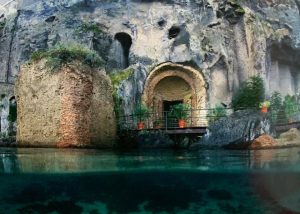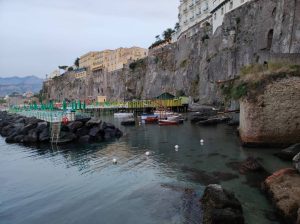
Today we want to introduce you to one of the most evocative yet little known archaeological sites in Sorrento.
“The planting of nymphaeums and fish ponds”
We find the remains of the structures built at sea level that were part of the complex of the Villa of Agrippa Postumo (nephew of the Emperor Augustus) I century. BC, an extraordinary Roman Domus.
- The maritime layout of the villa was the most important element and is made up of a Major Nymphaeum, which was entirely covered with mosaic, and a Minor Nymphaeum, covered with glass mosaic, both located in the tufaceous ridge under the current Villa Pompeiana.
- Inside the nymphaeum there were waterfalls thanks to a complex hydraulic system The bare and well-smoothed rock is the dominant element, but where the tufaceous rock was missing, the construction technique of the reticulate was adopted (opus reticulatum or reticolatum) still clearly visible .
- The remains of the nymphaeums, dating back to the second half of the second century. a.c., which constitute the most extraordinary ensemble of this kind of works that is preserved today, is accessible on foot via a small path that passes behind the bathing establishments of the beach of San Francesco. The beach can be reached on foot or by lift from the Villa Comunale in the historic center of Sorrento or from the Marina Piccola (the Port of Sorrento from where hydrofoils leave for the islands of Capri, Ischia and Procida, Positano, Amalfi and Naples.

The fish pond, on the other hand, can only be visited by sea, at the time the sea water was about one meter lower as can be seen from many structures that are now submerged, including the walkways inside the cave.
- In the Roman civilization, as in the Greek one, nymphaeum refers to those structures where people stopped, banquets were set and where moments of otium were spent.
- The fish pond was a fish farming system widely used by the ancient Romans and was used to preserve freshly caught fish in artificial tanks, in order to keep it alive until consumed, or to preserve it through the salting process.
- The more than 2,000 years of history, the looting and the storms, have pulverized much of this extraordinary home. But still today, by carefully observing the tunnels, the artificial canals where the water sources gushed out and the now bare nymphaeums with crystallized salt between the lines of the opus reticulatum, you can glimpse a piece of Sorrento history.

